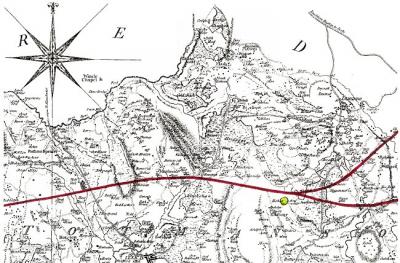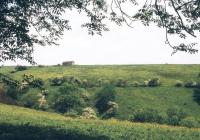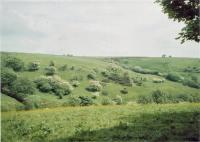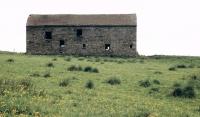
Nat Gould
His life and books
Herbage
Before William Gould 1655-1725 moved to The Lowe near Longnor in Staffordshire, and subsequently to Pilsbury Grange in 1684, he and his ancestors had lived for generations at Herbage, high on the moorlands of Staffordshire between Leek and Longnor (1). Although this place seems remote today, it was once on a strategically important long-distance route from west to East across England.
Medieval monks built up a huge and profitable trade in wool. Locally the Cistercian monks of Dieulacres Abbey at Leek had similarly prospered. When the abbeys were destroyed in the 1530s, the sheep and wool trade was taken up, not so much by aristocratic families, but by yeoman farmers such as the Goulds. The aristocrats had turned from sheep farming to cattle ranching.
The richest market for English wool was on the European continent, particularly Florence. But how did yeomen such as the Goulds transport wool from their sheep flocks?

Great Drove Road from Cheshire (Herbage marked in green)
Nowadays we think of the main travel routes in England as being north-south. Railways and motorways run mainly in that direction. West-east links north of London are secondary. But that was not always so. In the Peak District there were important transport routes across the country west-east. Until well into the eighteenth century such transport was by one of two methods - on foot or by animals, especially the Galloway pack horses.
Today we think of the occasional farmsteads among the bleak Staffordshire moors as being remote places, barely able to subsist and losing most of their children to faraway towns. But again that was not always the case. In the 1500s and 1600s they were highly productive and well connected to their markets. Wool from the Peak District went by packhorse trains across the country to the river ports of Doncaster and Torksey (2).
Meanwhile vast herds of cattle were on the move across the country. Although the Goulds may not have been directly involved in cattle rearing and marketing on the huge scale promoted by the aristocrats in more lowland areas of England, they would have profited from this trade also. Herbage lay right in the centre of the Great Drove Road from Congleton on the Cheshire plain over the hills and moors of the Peak District onwards to Nottingham and the Trent valley (3). Drovers needed overnight stops for the cattle and themselves, and Herbage was exactly the sort of place to provide those necessities.
(1) The photographs on this webpage have been kindly provided by Michael and Ann Hanson and were taken in 2009. The line of the Great Drove Road has been drawn on a scan of the 1775 Yates map of Staffordshire.
(2) Just before reaching Doncaster, Gould wool would pass through Sheffield (then expanding westwards into Morewood territory) and Rotherham (home of the Hollis family). It was a profitable trade, and the Goulds grew wealthy. The £126 dowry brought by Mary Hollis would be about £250,000 in wage terms today - and the first William Gould of Pilsbury Grange left £100 to each of his children not bequeathed a farm or other livelihood. The Earl of Devonshire's steward would have been delighted to secure such a tenant for Pilsbury Grange.
(3) The South-West Peak: History of the Landscape Eric Wood (2007) pages 52 to 54. This pioneering book provides a scholarly but very readable account of this neglected area of the Peak District.



